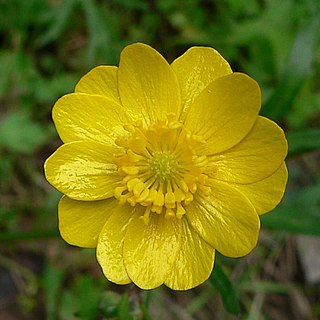
Ranunculus californicus, commonly known as the California buttercup, is a flowering plant of the buttercup family Ranunculaceae. It is a native of California, where it is common in many habitats, including chaparral and woodlands.

Allium validum is a species of flowering plant commonly called swamp onion, wild onion, Pacific onion, or Pacific mountain onion. It is native to the Cascade Range, to the Sierra Nevada, the Rocky Mountains, and other high-elevation regions in California, Oregon, Washington, Nevada, Idaho and British Columbia. It is a perennial herb and grows in swampy meadows at medium and high elevations.

Ranunculus glaberrimus, the sagebrush buttercup, is a species of flowering plant in the buttercup family, Ranunculaceae. It is native to interior western North America, in western Canada, the western United States, and the northwestern Great Plains.
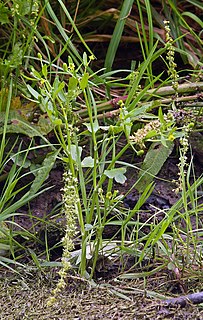
Ranunculus sceleratus known by the common names celery-leaved buttercup, celery-leaf buttercup, and cursed buttercup is a species of flowering plant in the buttercup family Ranunculaceae. It has a circumpolar distribution in the northern hemisphere, native to temperate and boreal North America and Eurasia, where it grows in wet and moist habitats, including ponds and streambanks.
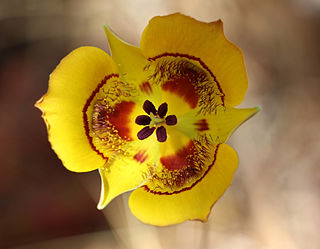
Calochortus clavatus is a species of mariposa lily known by the common name clubhair mariposa lily. It is endemic to California where it is found in forests and on chaparral slopes.

Kumlienia hystricula is a species of flowering plant in the buttercup family known by the common name waterfall false buttercup.

Alisma lanceolatum is a species of aquatic plant in the water plantain family known by the common names lanceleaf water plantain and narrow-leaved water plantain. It is widespread across Europe, North Africa and temperate Asia. It is naturalized in Australia, New Zealand, Oregon, California and British Columbia. It is considered a noxious weed in some places.
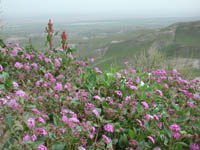
Abronia pogonantha is a species of flowering plant in the four o'clock family (Nyctaginaceae) known by the common name Mojave sand-verbena. It is native to California and Nevada, where it grows in the Mojave Desert, adjacent hills and mountains, and parts of the San Joaquin Valley in the Central Valley.
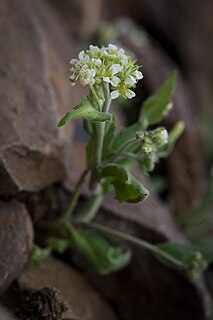
Draba breweri is a species of flowering plant in the family Brassicaceae known by the common names cushion draba, Lanceleaf Draba, Brewer's draba, and Brewer's Whitlow grass. With Draba cana now considered a variety of this species, it is distributed throughout parts of northern and western North America, including much of Canada and the western United States. The less widespread var. breweri is limited to mountainous California and western Nevada.

Ranunculus andersonii is a species of buttercup known by the common name Anderson's buttercup. It is native to the western United States, including the Great Basin and surrounding regions, where it grows in sagebrush, woodlands, and other habitat. It is a perennial herb producing a basal rosette of thick leaves which are each divided into three double-lobed leaflets at the end of a petiole. The inflorescence arises from the rosette on an erect, leafless stalk usually no more than 20 centimeters tall. It bears one flower with usually five white or red-tinged petals each up to 2 centimeters long with white or pinkish sepals at the base. At the center of the flower are many yellow stamens and pistils. The fruit is an achene, borne in a spherical cluster of 14 or more. It was named after Charles Lewis Anderson by Asa Gray.
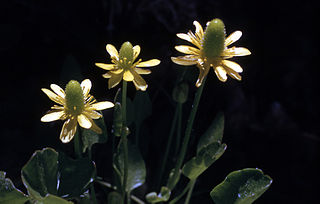
Halerpestes cymbalaria is a species of buttercup known by the common names alkali buttercup and seaside buttercup. It is native to much of Eurasia and parts of North and South America, where it grows in many types of habitat, especially in moist to wet areas such as marshes, bogs, and moist spring meadows. It is a perennial herb producing several stems a few centimeters to nearly 40 centimeters long. Some are prostrate against the ground and are stolons which root in moist substrate, and some are erect. The leaves are variable in shape, the basal ones with notched or slightly divided leaf blades borne on long petioles, and any upper leaves much reduced in size. The inflorescence bears one or more flowers on erect stalks. The flower has five to eight pale yellow petals, each under a centimeter long. The protruding receptacle at the center of the flower becomes a cylindrical cluster of fruits, each of which is an achene.

Ranunculus parviflorus is a species of buttercup known by the common name smallflower buttercup. It is native to Europe, but it is known on other areas of the world as an introduced species and sometimes a roadside weed, for example, in parts of Australia and the United States.

Ribes velutinum is a species of currant known by the common name desert gooseberry.

Sagittaria cuneata is a species of flowering plant in the water plantain family known by the common name arumleaf arrowhead or duck potato. Like some other Sagittaria species, it may be called wapato. It is native to much of North America, including most of Canada as well as the western and northeastern United States.

Trautvetteria is a genus of flowering plants in the buttercup family. Today it is often considered a monotypic genus, containing only one species, Trautvetteria caroliniensis, which is known by the common names Carolina bugbane, false bugbane, and tassel-rue. A second species, T. japonica, is now generally considered a variety of this species. The genus is named for the botanist Ernst Rudolf von Trautvetter.

Arnica dealbata is a species of Californian plants in the tarweed tribe within the aster family
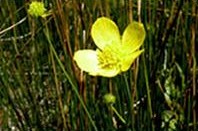
Ranunculus aestivalis is a rare species of buttercup known by the common names fall buttercup and autumn buttercup. It is endemic to the state of Utah in the United States, where it exists only in Garfield County next to the Sevier River. It is restricted to a moist microhabitat in an otherwise dry, open ecosystem, and the amount of available habitat is very limited. This is a federally listed endangered species of the United States. It has been described as "the most graceful and showy members of the genus in the western United States," but also "one of the state's rarest and most restricted plants."

Artemisia norvegica is a species of flowering plant in the aster family known by the common names alpine sagewort, boreal sagewort, mountain sagewort, Norwegian mugwort, arctic wormwood, and spruce wormwood. It is found in cold locations in Eurasia and high altitudes and high latitudes in North America.
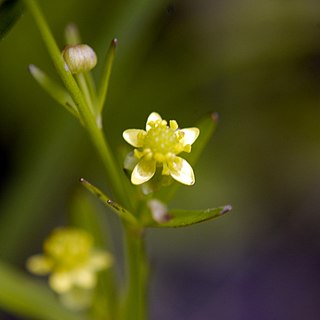
Ranunculus abortivus is a species of flowering plant in the buttercup family, Ranunculaceae. Its common names include littleleaf buttercup, small-flower crowfoot, small-flowered buttercup, and kidneyleaf buttercup. It is widespread across much of North America, found in all ten Canadian provinces as well as Yukon and the Northwest Territories, and most of the United States, except Hawaii, Oregon, California, and parts of the Southwest.
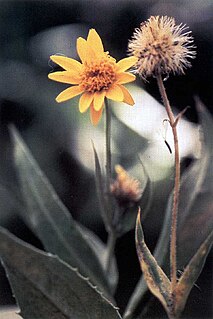
Arnica lanceolata is a North American species of flowering plant in the family Asteraceae, known by the common name clasping arnica or lanceleaf arnica. It has a disjunct (discontinuous) distribution in western North America and northeastern North America.




















